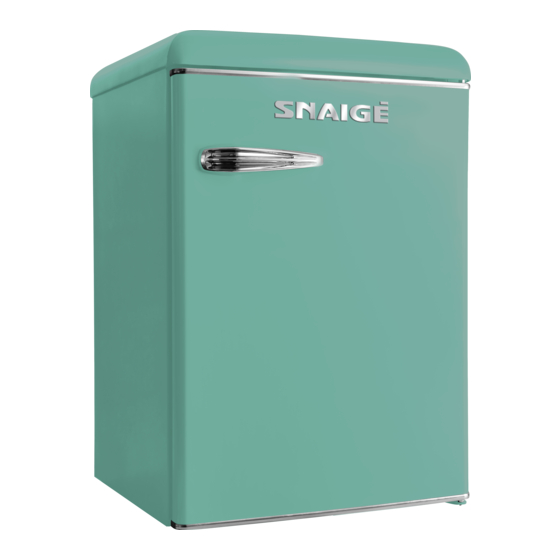Table of Contents
Advertisement
Quick Links
Advertisement
Table of Contents

Subscribe to Our Youtube Channel
Summary of Contents for SNAIGE R 13SM
- Page 1 Refrigerator with a freezer compartment R 13SM Instructions for Use...
-
Page 2: General Information
DEAR CUSTOMER! Some provisions in this user manual are unified for refrigerating products of different types (for a refrigerator, refrigerator-freezer or freezer). CAREFULLY READ THE INSTRUCTION MANUAL. The Manufacturer shall not be held liable for damage arising from the failure to observe the instructions contained in this manual. - Page 3 This appliance is not designed for the storage of explosive substances such as – aerosol cans with a flammable propellant. It is prohibited to store petrol and other flammable liquids near the appliance. – The appliance should be used only for storing foodstuffs. –...
- Page 4 The frequency and power of the electricity supply in your house must conform to – the general data parameters of the appliance as it is shown in the product label. When positioning the appliance, be careful that the electrical cord isn’t squeezed –...
-
Page 5: Installation And Operating Conditions
INSTALLATION AND OPERATING CONDITIONS Positioning: This appliance can be installed in a dry, well ventilated indoor where the ambient • temperature corresponds to the climate class indicated on the rating plate of the appliance. Do not install this appliance in areas that are too humid or too colds, such as the construction appendices, garages or wine cellars. -
Page 6: First Use
The appliance should not be connected to the mains until all packing and transport materials aren’t removed. Suitably dispose the packaging material. First use: Before using the appliance for the first time, the interior and all internal accessories • should be washed with lukewarm water and some neutral soap to remove the typical smell of a brandnew product, then dried thoroughly. -
Page 7: Temperature Regulation
TEMPERATURE REGULATION The temperature in the refrigerator compartment is controlled using the thermostat knob 3 (fig. 1) by turning it to one side or the other. The temperature indication in digits is shown beside the thermostat knob 3. The temperature is regulated on a scale of seven digits. 0 = Compressor is switched off. - Page 8 Fresh food for freezing should not touch already frozen foodstuffs. Do not freeze foodstuffs that are warmer than the room temperature WARNING! Do not freeze liquid foodstuffs in glass vessels or bottles. Strictly observe the frozen foodstuffs validity dates indicated by ...
-
Page 9: Changing The Interior Light Bulb
CHANGING THE INTERIOR LIGHT BULB When changing the interior light bulb (fig. 6), do the actions below in the order they are listed: Unplug the appliance from the mains by pulling the plug out of the electricity supply socket. Press the latch on the interior light bulb ... - Page 10 10. Take the cap (12) off the refrigerator door and press it into position on the opposite side. 11. Remove the bracket (13) and its washers from the axle. Unscrew the axle by twisting it counter-clockwise. Turn the bracket upside-down (180 º) and screw in the axle. Attach the bracket on the opposite side.
- Page 11 OPERATION PROBLEMS AND THEIR SOLUTIONS (TROUBLESHOOTING). What if… The appliance is plugged in to the mains but it does not work and. Check that • your house electricity supply installations are in order. Check that the plug is correctly inserted into the electricity supply socket. The noise has become louder.
-
Page 12: Environmental Protection Information
ENVIRONMENTAL PROTECTION INFORMATION This appliance is marked according to the European directive 2002/96/EC on Waste Electrical and Electronic Equipment (WEEE). By ensuring this product is disposed of correctly, you will help prevent potential negative consequences for the environment and human health, which could otherwise be caused by inappropriate waste handling of this product.

















Need help?
Do you have a question about the R 13SM and is the answer not in the manual?
Questions and answers